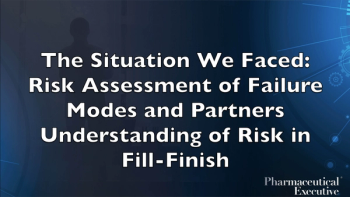
- Pharmaceutical Executive-05-01-2011
- Volume 0
- Issue 0
High-Risks to High Reward
According to Eli Lilly, managing alliances requires more than good people skills
In the world of biopharmaceutical partnerships, the number and value of alliances are at historical peaks. Intense pressures to fill pipelines, lower development costs, and bring products to market are inspiring pharma and biotech companies to join together in increasingly complex ways.
As these relationships become more complicated, expensive, and integral to business strategies, in-house alliance management functions are bearing greater responsibility for the progress—as well as the outcome—of major partnerships. Firms both large and small are struggling with the realization that in most cases, traditional alliance management methods are insufficient to support that growing weight.
So what's the best way to tackle the broad spectrum of issues presented by multifaceted alliances? In our experience, you must first take the big-picture view of alliance management—and then apply specific, common-sense tools to mitigate the risk and maximize the value of these vital strategic partnerships.
New Tools of the Trade
Since Lilly first established an office dedicated to alliance management in 1999, the alliance practice has evolved from managing relationships to minimizing risk. Today every strategy, approach, and tool we employ springs from one common purpose: to proactively mitigate and manage the business risk, human risk, and legal uncertainties inherent in every alliance.
As our philosophy has evolved, so too have the tools we use to manage alliances on a daily basis. Some foundational elements of our practice include:
» 3-D fit analysis: a tool used to assess partnership compatibility across three dimensions: operational, strategic, and cultural;
» Governance implementation: leading and influencing effective governance meetings, including proper meeting frequency, appropriate agenda topics with clear objectives, internal premeeting alignment, participants with decision-making authority, and documentation of appropriate decisions and actions;
» Strategic futures exercise: a tool that provides the foundation for a successful alliance startup by generating mutual long-term goals, understanding potential obstacles, and aligning on guiding principles and behaviors that will help the team overcome potential obstacles; and
» Voice-of-the-Alliance (VOA) health assessment: an annual assessment performed on major alliances to gauge the current state of the partnership and identify issues requiring attention.
Armed with the knowledge that our main objective is to reduce risk in every alliance and ultimately generate something of value, we have developed a series of new tools to use as each relationship and project progresses. These tools provide us with the specific means to mitigate all the risks that we encounter at the onset of a partnership, during the execution phase, and in all ongoing interactions thereafter. While we can't cover every available method, we offer here several representative examples.
Contingency Planning
While contingency planning is a relatively common concept, its use is not widespread in alliance management. In some cases, business partners don't want to introduce any negativity—such as the thought that the project might not reach certain milestones or that it might fail on technical grounds. In other situations, team members might find scenario planning a distraction in an action-oriented project and give it low-priority status. For any number of reasons, the team often stays in reactive mode, thinking, We'll cross that bridge when we come to it.
Lilly's alliance management team is taking a more proactive approach. Our clients have seen firsthand the benefits of alliance contingency planning efforts that address possible outcomes of major events, such as the release of results from a major trial or FDA advisory board meeting. These exercises are useful because very often these situations are highly emotional and significant to the business, and there is little time to react to the release of study data or FDA decisions. Having discussed the possibilities—and our public responses to any number of outcomes—ahead of time, our teams are much better prepared to work together and to make rational decisions quickly. Teams are able to communicate relevant information rapidly to all important internal and external stakeholders.
Another common source of business risk is leadership turnover, which occurs through attrition, restructuring, or even new opportunities that arise for particular individuals. While many companies leave new team members to learn as they go through trial and error, we pay careful attention to changes in staffing. We then take the time needed to bring new leaders up to speed using the comprehensive background materials we have created over the course of the alliance. This process enables us to affirm the business goals of the partnership and avoid any barriers to project progress.
Document Everything
In any group effort, clarity regarding who made which decisions, who agreed to them, and who will implement them is key. Because memories are never perfect and interpretations often vary, we have found it eminently useful to create and maintain appropriate records of alliance decisions and the action items that result.
It's important to note that we are not simply writing down everything that is said at a given meeting. While we do assign one person to capture the content, our involvement as alliance professionals goes further. Before we adjourn our governance meetings, for example, we record all decisions, then review and approve them with everyone in the room. This provides the opportunity for clarification while the discussion points are still fresh, and team members can agree on any modifications.
This process allows for both organizations to align and agree upon future actions, with the additional benefit of bringing to light basic missteps that have the potential to create problems downstream. For example, the review and agreement process might highlight a case where the true decision-maker was not in the meeting, which might become problematic as decisions are re-visited and questioned later.
By maintaining appropriate records of joint decisions, alliance management in turn becomes the repository of project information. These records are available in case questions arise or when new team members need to be brought up to speed. Our integral involvement in such activities also ensures that we have early notice of potential risk factors, and that we can identify and address issues before they become bigger problems for the alliance.
Lessening Human Risk
While the reduction of business risk and legal uncertainty plays a large part in mitigating sources of conflict between team members, human interactions always contain the potential for tension and discord. Drawing on Lilly's expertise in neuroscience and psychiatry, we have developed tools that help participants manage their way through various situations and deal with the differences in outlook and opinion that invariably exist in group settings.
One such tool is a short video we created to demonstrate how quickly situations can deteriorate under certain circumstances, when the stakes are significant and emotions are running high. After viewing the video, the question for team members becomes: How can we prevent this from happening to us? The ensuing discussion is always valuable, as we talk about ground rules for respectful interaction, the importance of reliability and trust, and techniques for staying objective and on-task.
Another tool we have found extremely worthwhile is the use of structured listening, in which one person is chosen to speak for each team in a particular discussion. This method is effective especially when the subject matter is complicated or opinions—even among the same team—diverge widely. By funneling communication through one person, each group must achieve consensus on an issue before presenting its case. Structured listening has the effect of forcing each side to actively hear the other's opinion and respond to the content, not the delivery, of the message.
Minimizing Risk = Value
Effectively managing alliances is no easy task, but it can and must be done. Over the last decade, we have seen firsthand how a redefinition of our group's role—from facilitating relationships to mitigating risk—has made a positive impact in strategic collaborations at all levels. Whether the nature of the services we provide is proactive (contingency planning, decision documentation, and conflict management training) or reactive (crisis management and problem solving), our methods aim to reduce business risk, human risk, and legal uncertainties.
Most significantly, our approach and efforts serve to remind everyone on the team that working together to minimize risk and mitigate potential conflict will help us achieve our common goal of generating a valuable product.
David Thompson is the Chief Alliance Officer at Eli Lilly. He can be reached at
Steven Twait is Director of Alliances and M&A Integration at Eli Lilly. He can be reached at
Articles in this issue
over 14 years ago
Pharmaceutical Executive Digital Edition - May 2011over 14 years ago
Malaysia: The Overlooked Emerging Marketover 14 years ago
UK Stakeholders Have Their Say on Value-Based Pricingover 14 years ago
Expanded Liability for Generic, Brand Manufacturers Ahead?over 14 years ago
Using Social Networks to Guide Product Spendover 14 years ago
iDeal Tool of Sales Tradeover 14 years ago
The Elusive Single-Point-of-Entryover 14 years ago
Outrage Over Drug Pricesover 14 years ago
Seeing Through the Transparency Directiveover 14 years ago
On Tour with Merck's RobotsNewsletter
Lead with insight with the Pharmaceutical Executive newsletter, featuring strategic analysis, leadership trends, and market intelligence for biopharma decision-makers.





